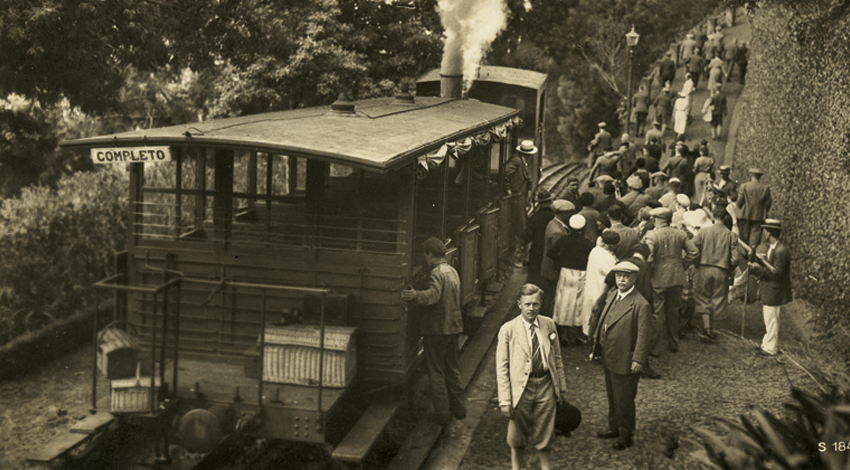A comfortable means of reaching Monte, an icon for tourists and the site of an explosion. So goes the 50 year long story of Madeira’s railroad.

Going up to Monte via cable carts is one of the most common activities for tourists on the island. It has been so since the year 2000 when the cable carts station connecting the oldtown to Monte in 15 minutes was inaugurated.
Perhaps surprisingly so, over a hundred years ago, things were not so different at least as far as this tourist activity goes. In fact, the creation of the cable carts came to replace the void left by the extinction of one of the oldest means of reaching the parish of Monte: the train.
The history of Madeira’s railway goes as far back as the late 19th century. António Joaquim Marques, born in Lisbon, is said to have presented the Town Hall of Funchal with the first proposal for a connection between the town centre and Monte.
But the project did not come through and the license was given to Madeiran Manuel Alexandre Sousa. It was not until 1891 that the project was given a green light. Doon thereafter a railway company known as Companhia do Caminho de Ferro was established.
The first leg of the railway was inaugurated in July 1893. It connected Pombal to Levada de Santa Luzia. A year later, in August, the second leg, leading to Atalhinho and comprising 2.5 kilometres, was inaugurated.
According to an old encyclopaedia about Madeira, in 1910, after ‘a meeting of the Railway Company of Monte’s general assembly it was settled that the railway ought to be extended to Terreiro da Luta’.
And as such, June 24th 1912 saw the inauguration of the last section of railway, reaching Terreiro da Luta. The railway was now almost four kilometres long and rose up to nearly 850 metres above the level of the sea, the altitude of Terreiro da Luta where there was a train station, naturally, as well as a restaurant and a tea house, sporting one of the best views of Funchal.
Operating in that which was an era of growth for tourism in Madeira, the Train of Monte was a true tourist icon. For instance, Max Römer, a German painter and one of the most prolific producer of watercolours with the island for their setting, immortalized the train in several postcards he painted.
Going up to Monte was a favourite for those on board the many cruises that would call at Funchal and quite often, for several hours.

Just as they entered the town they would board on an ‘American Car’, an animal-powered streetcar which would take them to the train station at Pombal and from there they would travel to Monte.
On September 10th 1919, around 6 p.m., the locomotive left the station, as per usual, and headed to Monte. Aboard were 56 passenger, tourists and locals. After the first kilometre there is a sudden explosion in the locomotive’s engine.
The burst was strong enough that the sound could be heard a bit everywhere around town. The September 11th edition of the local newspaper actually mentions how ‘many people assumed it was something underground’ and that it was not until later that confirmation came about the noise’s origin.
Four people died in this accident, the driver and the person in charge of the steam engine being two of them, and there were several other injured people. As a consequence, the railway was shut down for 5 months. It reopened on February 1st 1920.
It would survive for another 23 years until it was permanently shut down in 1943. The growing popularity of the automobile and the crisis brought about by WWII had left the island with dwindling numbers of visitors and made the train rather redundant.
According to the same encyclopaedia, at the time of its shutdown, the firm was in possession of ‘four locomotives and five wagons’ for passengers with a capacity for 60 people each.
Though decades may have passed, memory of the train remains in the city’s collective memory and is illustrated in its toponymy. Rua Nova do Comboio, Impasse do Comboio; and Travessa do Comboio all share a word and that word is train (‘comboio’). Furthermore, in Rua do Pombal, the old building where the railway station used to be housed still stands tall, even though it is abandoned and has been left untouched for years.
The station at Monte still exists. Though the one at Terreiro da Luta now serves as an estate where private events are held. Restored in 2014, it sports a privileged view of the harbour of Funchal and is usually chosen by several couples as a venue for their weddings.
Almost 125 years after its inception, the route connecting the heart of the city to Monte is still very much alive. Nowadays, though, the travel takes one across the heavens and the views one gets from there, are quite different.














